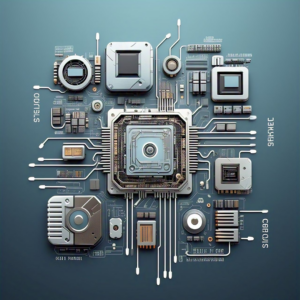
Introduction to High-Speed Computation
High-speed computation plays a crucial role in modern technology. It powers advancements in artificial intelligence, big data analytics, and real-time processing. As technology evolves, hardware improvements have significantly enhanced computational capabilities. Faster processing speeds, increased efficiency, and the ability to handle large datasets make high-speed computation essential. This blog explores the key hardware components driving this field, their capabilities, and the future trends shaping computational advancements.
1. Hardware Systems in High-Speed Computation
High-speed computation depends on various hardware components that enhance performance for different tasks. The key components include:
1.1. Central Processing Units (CPUs)
CPUs act as the core of computing systems. Modern CPUs are designed with multiple cores, allowing them to execute multiple processes simultaneously.
– Multi-Core Architecture: CPUs today feature multiple cores, sometimes up to 64, enabling parallel processing for faster execution.
– Clock Speed: A CPU’s clock speed, measured in gigahertz (GHz), determines how many instructions it processes per second. Higher speeds lead to improved performance, but architectural design also plays a crucial role.
1.2. Graphics Processing Units (GPUs)
GPUs, originally built for rendering graphics, have evolved into powerful processors capable of handling various computational tasks.
– Parallel Processing: GPUs contain thousands of cores that allow them to process multiple tasks at once, making them ideal for AI and scientific computing.
– CUDA and OpenCL: These frameworks enable developers to use GPUs for tasks beyond graphics, such as deep learning and simulations.
1.3. Field-Programmable Gate Arrays (FPGAs)
FPGAs are customizable circuits that can be configured for specific applications.
– Customizability: Unlike fixed-function chips, FPGAs can be reprogrammed to adapt to different tasks, making them highly flexible.
– Low Latency: These chips offer lower latency than CPUs and GPUs, making them ideal for real-time applications like telecommunications.
1.4. Application-Specific Integrated Circuits (ASICs)
ASICs are custom-built processors optimized for specific applications.
– High Performance: ASICs provide superior efficiency because they are designed for dedicated tasks.
– Energy Efficiency: Since they are built for specific functions, they consume less power, making them suitable for mobile and embedded devices.
2. Performance and Capabilities of High-Speed Computation Systems
To measure high-speed computation performance, key factors include processing speed, throughput, and energy efficiency.
2.1. Processing Speed
Processing speed determines how fast a system executes tasks. Several factors contribute to this:
– Clock Speed: A higher clock speed allows a CPU to execute more instructions per second.
– Instruction Set Architecture (ISA): The ISA defines the instructions a processor can handle, influencing its efficiency and speed.
2.2. Throughput
Throughput refers to the amount of data a system can process within a given time frame.
– Memory Bandwidth: Faster memory technologies, such as DDR5, improve data transfer rates and system performance.
– Data Parallelism: Systems designed for data parallelism process multiple data streams simultaneously, increasing overall throughput.
2.3. Energy Efficiency
Energy efficiency is vital for reducing operational costs and environmental impact. Contributing factors include:
– Power Consumption: Energy-efficient processors help reduce costs and environmental impact.
– Thermal Management: Advanced cooling techniques prevent overheating and ensure stable performance.
3. Algorithms and Applications
The power of high-speed computation is enhanced by specialized algorithms designed for different fields.
3.1. Numerical Algorithms
Numerical algorithms enable scientific computing and mathematical problem-solving.
– Matrix Operations: Many engineering applications rely on efficient matrix computations, which are well-suited for GPUs and FPGAs.
– Optimization Algorithms: Fields like finance and logistics benefit from optimization techniques that maximize efficiency.
3.2. Machine Learning Algorithms
Machine learning relies heavily on high-speed computation to train and execute models.
– Deep Learning: GPUs accelerate deep learning by processing large datasets quickly.
– Real-Time Inference: High-speed systems enable AI-driven applications such as autonomous vehicles and fraud detection.
3.3. Data Processing Algorithms
Data processing algorithms enable efficient management of large-scale data.
– Stream Processing: Systems that analyze data in real time support applications like financial trading and network security.
– Batch Processing: High-speed computation allows for the rapid analysis of extensive datasets.
4. Future Trends in High-Speed Computation
Technological advancements continue to shape the future of high-speed computation. Key trends include:
4.1. Quantum Computing
Quantum computing represents a breakthrough in processing power. It leverages quantum mechanics to perform complex calculations exponentially faster than traditional computers.
4.2. Neuromorphic Computing
Neuromorphic computing models the human brain’s neural networks. This approach enhances pattern recognition and artificial intelligence applications.
4.3. Edge Computing
Edge computing reduces latency by processing data closer to its source. This technology is critical for IoT and smart city applications.
4.4. Advanced AI Algorithms
As AI grows more sophisticated, the demand for high-speed computation will increase. More efficient algorithms will enable better decision-making and automation across industries.
Conclusion
High-speed computation is a driving force behind modern technological advancements. It relies on powerful hardware, efficient algorithms, and evolving computing paradigms to enhance performance. As we move forward, new technologies like quantum computing, neuromorphic systems, and edge computing will further redefine computational capabilities. The continuous evolution of high-speed computation and future trends will unlock new possibilities, transforming industries and enabling groundbreaking innovations. Ultimately, this field will remain essential in shaping the future of computing.
Do you like to read more educational content? Read our blogs at Cloudastra Technologies or contact us for business enquiry at Cloudastra Contact Us.